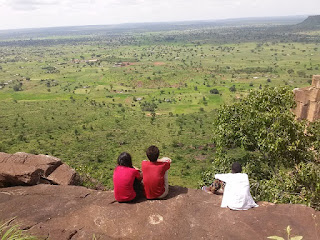I’ve now been at site for two full months, and teaching for a
full four weeks. And what an experience the Togolese classroom is! I feel a
little lucky that I’m doing this having never taught before… I can’t imagine being
an experienced teacher and having to adjust to the crazy differences in
education between the two countries.
My School - CEG Nassiete
Every morning, I wake up at 5:00, giving me enough time to eat
breakfast, get ready, and make the 15 minute walk to school by 6:45. At that
time, the “major generale” (the head student of the school) blows his whistle,
calling for each class to line up on the front lawn. We stand quietly and watch
as the Togolese flag is raised up on the big branch we use as a flagpole, and
then the major calls on one of the classes to sing the national anthem. Then
the whistle is blown again, students scatter back to finish sweeping the
classroom floors, and teachers do last minute prep in the office before first
period starts at 7:00.
The school is a big cement building
with five rooms – four classrooms and the office. Each room is big and airy,
with a big grid of window holes built into the walls. Wooden desks fill the
room, and each seats between one and three students, depending on the size of
the class. (My largest class, 108 students, has kids packed like sardines three
to a desk, with barely enough space for a skinny Togolese tween to navigate
between the rows. Me walking to the back of the classroom is out of the
question!) There are two large
blackboards, one at the front and one at the back of the classroom.
The school day goes until noon. Each grade has five classes,
55 minutes each, with a 25 minute break in the middle of the day. Each
classroom houses one grade, and students stay in their rooms for all of their
classes – it’s the teachers who switch around. At break time, two or three
women show up near the school to sell snacks – beignets, porridge, and plates
of rice with hot sauce.
I teach three grades – the sixieme (the youngest kids, just
out of primary school), cinquieme, and I co-teach the quatrieme with Monsieur
Kolani, the other English teacher at my school. I’ve already shocked you all
with the size of my sixieme class (I repeat – 108 kids!), but the other two
classes are more manageable, with between 40 and 50 students in each.
Not Actually Teaching, Just a Photoshoot
We’re expected to do three activities in each class –
usually a vocabulary lesson, a grammar lesson, and some kind of reading or
listening activity. Reading exercises are tough, because resources are tough to
come by. The school only has about 13 books for each class – and those are
ragged photocopies that my homologue painstakingly reglues at least once a week
– and even in my smaller classes, three students need to crowd around each copy.
Other exercises are tough, too, because of the number of students – Even if I
could call on everyone each class, it wouldn’t be nearly enough talking for
them to improve their English. Groupwork is a totally foreign concept in the
rote-memorization environment of Togolese school, but I’m trying to introduce
it little by little.
Though I’m not a Togolese student, I imagine the biggest
obstacle is having school entirely in French. It’s nobody’s first language –
children speak only Moba until they start learning French in primary school, and
though that’s earlier than most American s start a foreign language, it’s still
wild to me that by age 12, they’re required to attend a school where all
subjects are taught in the second language they’re learning. I couldn’t do
that. It’s totally impressive, and also no surprise to me if kids struggle!
There are five other teachers at my school – all men – and our
director. Other, larger schools have other authority figures (like a senseur,
or chief disciplinarian), but because we’re so tiny, a lot of those kinds of duties
fall on the teachers and director. So far, everyone has been very welcoming,
and are very lenient with the amount of non-teaching responsibilities I’m ready
to take on at the school!
Fellow Volunteer Morgan, Me, Kolani, and Soyenou
Kolani, the other English teacher at the school, is my Peace
Corps appointed counterpart. We’re all supposed to search out many homologues
to collaborate with, but he is my
springboard. He’s incredibly nice, and excited about being able to converse
with someone whose native language is English. We’re hoping to start an English
club at the school, and maybe a local English Teachers’ Club, for teachers in
neighboring villages to get together and talk in and about l’Anglais.
My other best friend at school is named Soyenou. He teaches
French and History/Geography, and has volunteered to help teach me Moba, the
local language. Twice a week, we meet at the school in the afternoon, where we
spend an hour learning new vocabulary words, and practicing sentences I can use
at the marche. “N bwa n da dam piile,” I find myself saying often, “I want to
buy 100 francs worth of Tchakpalo.”
Learning local language is a great key to integration. Nothing
seems to make my neighbors happier than being able to greet me in their mother
tongue. I’m not sure whether its sincere appreciation of the effort I’m making
to be a part of the community, or glee at the ridiculousness of some white girl
mispronouncing phrases they’ve known from childhood, but either way, I’m happy
to put a smile on someone’s face when I can answer “A saa le?” – “Where are you
going?” with a broken but confident “N saan kalatu je,” “I’m going to school,
but I’m coming back!”
















